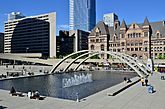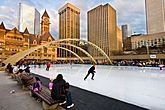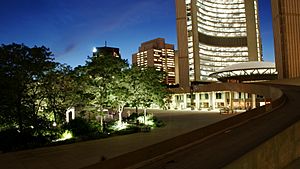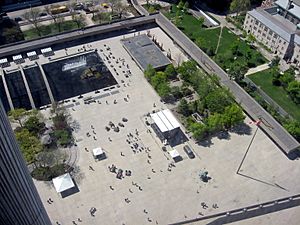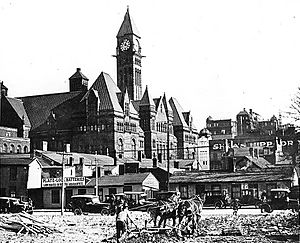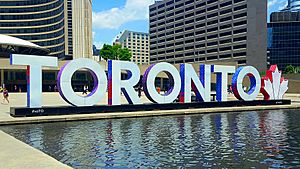Nathan Phillips Square facts for kids
Quick facts for kids Nathan Phillips Square |
|
|---|---|
| City square | |
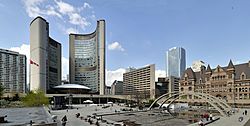 View of square from southwest |
|
| Features: | reflecting pool/skating rink; peace garden |
| Design: | Viljo Revell |
| Opening date: | September 13, 1965 |
| Amenities: | skate rentals;underground parking |
| Area: | 4.85 hectares (12.0 acres) |
| Surface: | concrete |
| Dedicated to: | Nathan Phillips, Mayor of Toronto |
| Owner: | City of Toronto |
| Location: | Bay Street and Queen Street Toronto, Ontario, Canada |
|
Location of Nathan Phillips Square in Toronto |
|
Nathan Phillips Square is a large open space, like a town square, in Toronto, Ontario, Canada. It sits in front of Toronto City Hall, which is also known as New City Hall. The square is located where Queen Street West and Bay Street meet. It is named after Nathan Phillips, who was the mayor of Toronto from 1955 to 1962.
The square was designed by the City Hall's architect, Viljo Revell, and a landscape architect named Richard Strong. It first opened in 1965. Nathan Phillips Square is a very busy place! It hosts many events like concerts, art shows, and a weekly farmers' market. In winter, it becomes a magical place for the Cavalcade of Lights Festival. The reflecting pool turns into an ice rink for ice skating. About 1.5 million people visit the square every year. At 4.85 hectares (12.0 acres), it is Canada's largest city square.
The square is often used for art exhibits, concerts, and public gatherings. Every year, there's a big New Year's Eve party and the lighting of the official Christmas tree. The annual Nuit Blanche art festival also sets up amazing art displays here.
Contents
What Can You See at Nathan Phillips Square?
The square has a rectangular shape. The City Hall building meets the square at an angle on the north side. Most of the square is paved with strong concrete slabs.
You can find a reflecting pool, a peace garden, a permanent stage, and several sculptures here. One famous sculpture is Three-Way Piece No. 2 (also called The Archer) by Henry Moore. An elevated concrete walkway goes around the edges of the square. Outside this walkway, there are grassy areas with trees and other statues. These include a statue of Sir Winston Churchill and a Roman column. Below the square is one of the world's largest underground parking garages. In 2012, cool "disappearing" fountains were added to the paved areas. These fountains light up and help keep the square cool. Nathan Phillips Square belongs to the City of Toronto. Smoking is not allowed anywhere in the square.
The Reflecting Pool and Skating Rink
The reflecting pool is in the southeast part of the square. Three concrete arches stretch across the pool. These arches were originally just for looks and to hold lights for the skating rink. In 1989, they were named the Freedom Arches. This was to remember people who fought for freedom. At the same time, a piece of the Berlin Wall was placed at the base of the middle arch.
To the west of the pool, there's a building where you can buy food. In winter, when the pool becomes an ice rink, you can rent ice skates there.
The Peace Garden
The Peace Garden was created to remember the atomic bombing of Hiroshima. It also shows that people in Toronto care about world peace. A sundial at the south end of the garden was there before the Peace Garden. It was put in place in 1969 by Nathan Phillips himself.
Fifteen years later, in 1984, then Prime Minister of Canada Pierre Trudeau started the work on the Peace Garden. The garden is about 600 m2 (6,500 sq ft) and has a pavilion, a fountain, and plants. The pavilion is a stone cube with arched openings. One corner of the pavilion is "broken" to show conflict and how fragile civilization can be. The fountain's pool flows into this broken corner. An eternal flame is placed in the water, looking like it supports the pavilion. This flame stands for hope and new beginnings.
Pope John Paul II lit this flame with a special ember from the Peace Flame in Hiroshima. He also poured water from the rivers of Nagasaki into the pool. Queen Elizabeth II, the Queen of Canada, officially opened the monument in October 1984. As part of a recent redesign of the square, the Peace Garden was moved to the western side.
The Elevated Walkway
A concrete walkway goes around the edge of the square. It connects to the City Hall building at the height of its roof. Stairs lead from the walkway down to the main square. On the south side, the walkway crosses Queen Street to the Sheraton Hotel. On the west side, it connects to the back of the permanent stage. This stage also works as a grand staircase. The walkway is closed during the winter months.
History of Nathan Phillips Square
The land where Nathan Phillips Square now stands was once a neighborhood called the Ward. In the early 1900s, many immigrants lived there. First, Black families settled there, then many Jewish immigrants from Eastern Europe. From the 1910s until World War II, Chinese immigrants gradually moved in and created Toronto's first Chinatown in this area.
Modern Changes to the Square
In 2006, a competition was held to find new ideas for improving the square. In 2007, a team led by PLANT Architect Inc. and Shore Tilbe Irwin + Partners won. The project was expected to cost about $60 million. It was mostly finished by 2014.
The new design was based on the idea that Nathan Phillips Square is like an agora. An agora was an ancient Athenian public space for talking and trading ideas. The design aimed to make the square feel like a "theatre for the city."
The plans included many new features:
- A new building for food and skate rentals, with a rooftop terrace.
- A two-level restaurant with outdoor seating.
- A glass building for tourist information.
- A new stage with a glass roof.
- More trees and plants around the edges of the square.
- An improved Peace Garden with more trees and a reflecting pool.
- A garden and café on the roof of City Hall.
- A restaurant and bar on the observation deck of the City Hall's east tower.
- Upgraded walkways with wood, seating, and better access.
- A seasonal "disappearing" water fountain in the center.
The redesign also focused on being environmentally friendly. This included better conditions for trees, more trees, and ways to save energy. There's even a cycle station with storage for 380 bikes and showers!
On May 29, 2010, Mayor David Miller opened the first part of the project: the Podium Green Roof Garden. This 1.1 hectares (2.7 acres) roof garden has many different plants and trees. It also has a central courtyard, a public terrace, benches, and a 500 metres (1,600 ft) path for walking or running. New lights were added for evening events.
The 2010s at the Square
In 2011, after the death of federal New Democratic Party leader Jack Layton, people gathered at the square. They wrote messages in chalk on the walls and statues to remember him.
During the 2015 Pan American Games, Nathan Phillips Square was a main spot for "Panamania." This was a cultural festival held with the Games. Two temporary stages were set up, and a platform was built over part of the reflecting pool. Every evening, there were concerts, medal celebrations, and fireworks. The square also had a countdown clock for the Games and a shop for souvenirs.
A large, colorful, lit-up 3-D Toronto sign was also put in the square for the Games. This sign quickly became very popular with both locals and tourists. It was supposed to be moved, but on September 13, 2015, it was announced that the sign would stay in the square permanently.
The square also hosted the closing ceremonies for the 2015 Parapan American Games. It was also a place for Wheelchair tennis during the 2017 Invictus Games.
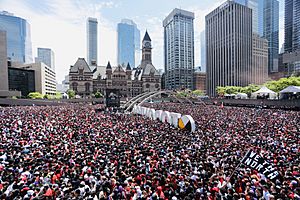
After the Toronto Raptors won the 2019 NBA Finals, their victory parade on June 17, 2019, ended at Nathan Phillips Square. About two million people attended, making it the largest public gathering for one event in Canadian history.
Images for kids
-
The Archer by Henry Moore, was installed in the square in 1966.
See also
 In Spanish: Plaza Nathan Phillips para niños
In Spanish: Plaza Nathan Phillips para niños


